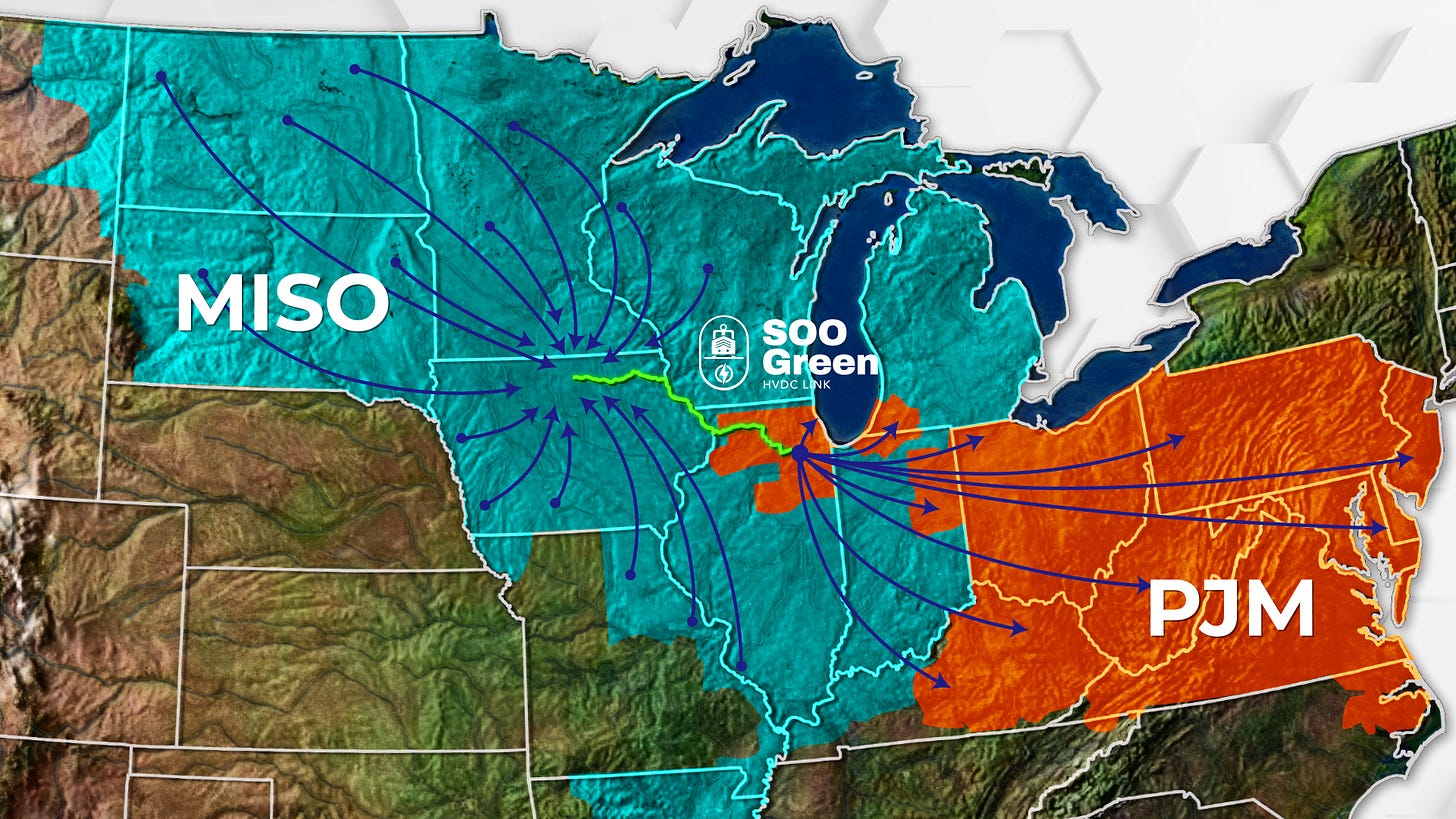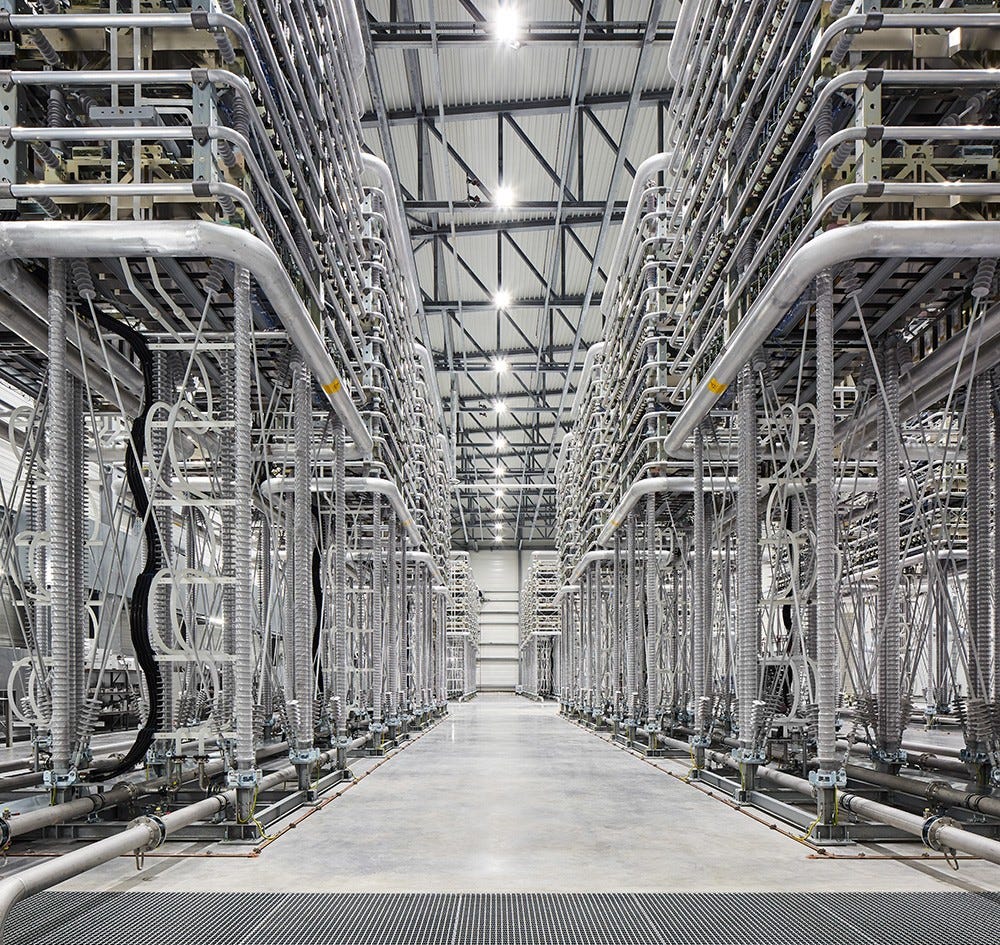Happy Monday! Welcome back to Transmission Fortnight here at Volts. Today’s a fun one.
In my previous post, I described the many difficulties facing new high-voltage, long-distance transmission projects, from planning to financing to permitting and siting. It’s a bureaucratic slog.
Today we’re going to look at a clever idea for bypassing many of those problems, namely, stitching together a national power grid by burying power lines along existing rail and road infrastructure, where rights-of-way are already established, thus eliminating the endless haggling with local governments and landowners.
The idea has been gaining steam in the policy community for the last few years. FERC issued a report in June on challenges to transmission; siting along existing infrastructure was cited as a promising solution. In his Build Back Better plan, Biden promised to “take advantage of existing rights-of-way — along roads and railways — and cut red-tape to promote faster and easier [transmission] permitting.” This op-ed in The Hill sums up the benefits quite nicely, both of a national grid and of building it without siting battles.
The vision is taking hold. And at least one small piece of that vision has gone beyond speculation into an actual permitting process.
The SOO Green line will carry Iowa wind power to Chicago
A company called Direct Connect is currently in the development and permitting phase of a privately financed, $2.5 billion project called the SOO Green HVDC Link, a proposed 349-mile, 2.1-gigawatt (!), 525-kilovolt transmission line to run underground along existing railroad from Mason City, Iowa, to the Chicago, Illinois, area. It aims to go into operation in 2024.
Going underground will allow the line to minimize environmental and visual impact. It will be much more resilient than an overhead line against weather, temperature shifts, sabotage, or squirrels.
Two side-by-side cables will run through tubes of Cross-Linked Polyethylene (XLPE) and will be self-contained, lightweight, and easy to handle. They won’t get hot, interfere with signaling equipment (unlike AC lines), or affect rail operations. There are fiber-optic sensors along the lines to monitor sound and heat for any problems.
(Nemo Link, the world’s first 400 kilovolt line using XLPE, runs undersea between the UK and Belgium; it began operation in January 2019.)
Running alongside the railroad means SOO Green will have no need to claim land via eminent domain. Almost all of that railroad is owned by Canadian Pacific (one of seven large “class one” railroads in the US), so there are a tractable number of parties to deal with.
A deal like this offers railroads a new passive revenue stream; royalty fees well exceed what they get from similarly buried fiber-optic lines, of which there are more than 100,000 miles along US railroads. And it’s also a chance for railroads to be part of a positive sustainability story.
The project is privately funded, so there will be no need for any complicated cost-allocation formulas. The financiers (including Siemens, which very rarely puts direct capital in transmission projects) will make their money back from those who use the line — the suppliers that put power on it, the shippers that sell power across it, and the buyers that consume the power — through competitive bidding for capacity. SOO Green is holding an open solicitation right now to allocate its 2,100 megawatts among them.
The aim is to create a more robust energy market by, for the first time, connecting the MISO and PJM territories. (MISO and PJM are regional transmission organizations; see previous post for details.) Wind power projects are backed up in MISO, waiting to connect, stymied by grid congestion. Meanwhile, nextdoor neighbor PJM is the largest liquid energy market in the world.
The idea is that SOO Green will unlock renewable energy development in MISO; Direct Connect projects four to six new gigawatts. That energy will be transported to population centers in PJM, easing grid congestion, reducing the carbon intensity of the East Coast energy mix, and lowering power prices.
The connection will also allow MISO and PJM to share reserves for the first time, which could reduce the need for reserve capacity, increase reliability, and save consumers money.
Because the MISO side will be drawing from such a geographically broad region, it is likely to be in use almost continuously. “When the wind isn't blowing in North Dakota, it likely is in Minnesota,” Trey Ward, the CEO of Direct Connect, told me. “We anticipate upwards of 90 percent line utilization.”
“It's as if we teleported a 2,100-megawatt wind turbine with a 90 percent capacity factor from Iowa into suburban Chicago,” he says. In fact, the converter station in PJM has applied to be treated as a capacity source in that market. (That will require some updating of regulations, just as power market regulations had to be updated to accommodate batteries.)
The converter stations at each end of the line are worth looking at more closely. They will use the latest generation of Voltage Source Converters (VSCs) to exchange power between the HVDC line and the regional high-voltage alternating current (HVAC) systems already in place.
VSC technology has been around since the late 1990s, but it has only recently gotten efficient, compact, and cheap enough to compete against the thyristors (solid-state valves) in common use today on HVDC lines.
VSCs boast several important advantages. Thyristors need strong AC systems on both sides of the line, they require power filtering, and they have limited control over reactive power. (Do not ask me, or anyone else, what “reactive power” is. That way lies madness.)
VSCs, on the other hand, are “self-commutated converters,” which means they can generate AC voltages (using IGBT capacitors) without relying on an AC system. They can control power independently, even with a weak AC system or no AC current at all; they can “black start” a grid from a blackout automatically, without any workers out throwing switches.
VSCs allow precise and instantaneous, bi-directional control of both active and reactive power. They can provide services to the grid other than just energy — things like voltage and frequency regulation or “synthetic inertia” to support grid stability.
“You can go from zero to 2,100 megawatts in 1/100 of a second, and back down again just as fast,” says Ward. “It will be the fastest, most dynamic resource on the North American grid.”
Power electronics experts have been claiming for years that VSCs would eventually replace thyristors in HVDC projects. (“We’re in a race with Germany,” Ward says.) If built, SOO Green would be a big step toward making it finally happen — the first deployment of VSCs at this scale in the world.
The main thing these VSC stations will do is serve as regional energy hubs, accepting gigawatts of energy from, or dispensing it to, existing HVAC grids.
Energy users that require a large, reliable supply of high-quality electricity, like data centers or technology parks (perhaps ensconced in microgrids), can co-locate with the hubs to take advantage of their high-quality power control, thus spurring economic development.
Direct Connect estimates that the SOO Green project will create 2,000 temporary construction jobs, unlock more than 4,000 jobs in renewable energy development, generate more than $2.7 billion in economic development in the two states, and yield more than $3.75 billion in ratepayer savings over 20 years.

We shouldn’t exaggerate how easy things will be for SOO Green. It won’t be completely free of siting hassles, and there are costs outside its control. (The X factor is the cost of copper for the lines themselves — if it spikes for some reason, SOO Green will be in trouble.) But its costs will be much more predictable than a typical overhead line’s. It knows its exact route from the beginning and, because digging ditches is a pretty cheap and well-established technology, 80 percent of its construction costs will be for equipment.
Things might be trickier for the next rail-transmission project. SOO Green is exploiting ideal conditions: a low-use railroad with well-characterized geology, connecting an energy-producing region with an energy-consuming one. Future projects could face more physical and economic challenges. At some point, there will be projects that don’t pencil out for private capital, but are needed to link the lines together into a national grid; then public money will have to step in.
But private capital can do a lot. Ward mentions two federal policies that could help. One is a federal investment tax credit (ITC) like the one renewable energy receives, to defray the cost of investment, especially for early and pioneering projects. (More details on that in the previous post.)
The other is some kind of manufacturing tax credit to spur more US companies to manufacture the XLPE line that Direct Connect is currently buying overseas.
Even without those policies, though, things are more or less on track (har har) for SOO Green.
If things go well for the project — no sure thing, given America’s history with transmission — it could serve as a template for new HVDC backbones along other sections of the elaborate US rail network. Ward estimates that as few as a half-dozen such lines would completely transform the US electricity system and spark billions of dollars of renewable energy development. (Direct Connect is in talks with all the class one railroads.)

An aside: as long as we’re talking about electricity and railroads, you should check out Solutionary Rail, a plan to run (overhead catenary) electricity lines along the nation’s rail lines and electrify rail freight in the process.
Anyway, to date there are no HVDC lines being planned along roads or highways, in part because state Departments of Transportation are always thinking about adding lanes, in which case the lines would have to be moved.
But it’s also because developers still have an inflated sense of the cost of undergrounding lines. The news hasn’t widely spread that modern lines require less conducting metal, horizontal drilling has been perfected by natural gas frackers, and inverter stations are as little as 25 percent the size they used to be.
Here’s what Dr. Christopher Clack, an energy modeler at Vibrant Clean Energy (VCE), told me:
Data that I was provided from Tier 1 transmission vendors shows that the cost of underground HVDC transmission has a similar price point to the same overhead capacity of HVAC when the transmission line is over approximately 250 miles. This includes the cost to build inverter and rectifier stations at each end.
And of course the sticker price of building overhead lines does not include the unpredictable expenses of regulatory hassles and intransigent landowners. A line can not be cheap if it never gets built.
In terms of long-distance transmission, underground HVDC is now the smart choice.
But there’s one other step planners and developers can take to bypass conventional transmission hassles.
A national grid made of two-state pieces
VCE is currently working on a detailed modeling exercise showing how the US can decarbonize by 2050. (You can see a preview here.)
The modeling (like much other modeling before it) shows that a national HVDC network is desperately needed for decarbonization. But VCE is aware of the difficulty of siting lines that cross multiple states. So it came up with a way to create a national network that is comprised entirely of lines that only bridge two states — each one originates in one state and terminates in a neighboring state. And every one of the major HVDC trunk lines is underground, running along rail or road infrastructure.
Here it is (a fancier map with more precise routes will be coming with the final release):

The two-state pieces are like Legos from which a national grid can be built. “You can get [energy] from Colorado to Chicago,” Clack told me, “but you have to go through five rectifier stations. It is the same as having one line.”
Building the system this way does come at some additional cost, since the VSC stations at the terminus of each line are expensive, and this would involve building more of them. And since each conversion of energy loses a little bit, all the additional conversions would add up to about 0.5 percent more “line loss.”
But the advantage of this approach is that “each line is just a contract between two states,” Clack says. “You would never have a flyover state and you would never have a state that wouldn't get access to the market.” Each participating state would have one or more energy hubs and all the advantages — economic development, less grid congestion, lower power prices — they bring. The end result would be a functioning national energy grid. Clever!
(When VCE’s modeling is officially released I’ll take a closer look at how the national grid operates and what it accomplishes.)
Let’s do this
A national energy grid composed of underground HVDC lines running along existing rail and road infrastructure, with VSC stations in every state, is an absolute home run of an idea. It ticks every conceivable box: it’s economic development, jobs, clean energy, lower prices, and most of all, an ambitious national project that we can accomplish, red and blue states together, to regain some of America’s lost mojo.
What’s more, transmission hasn’t yet fallen under the shadow of partisanship, unlike … everything else. There is bipartisan appetite for infrastructure spending and for unlocking the domestic renewable energy that is often concentrated in red states and needed in blue ones.
An underground national HVDC network would create thousands of jobs and bring hundreds of millions or even billions of dollars of new economic development to every single US state. It would save every American money on their power bills. It would bring national decarbonization within reach.
It would literally do what Biden promised: bring people together. We should build it!













